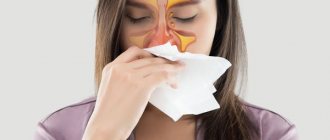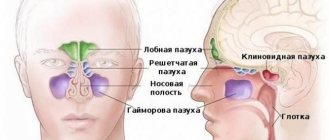Causes
The main causes of the disease are:
- injuries of the maxillary sinuses that violate the integrity of the mucous membrane;
- mechanical damage to the nasal septum;
- not fully cured runny nose, ARVI, flu;
- congenital anomalies of the structure of the nasopharynx organs;
- penetration of pathogenic bacteria, viruses, fungi;
- constantly dry air in the room;
- chemical burns of the mucous membranes of the sinuses;
- polyps, adenoids;
- malignant neoplasms;
- allergy;
- various systemic diseases (tuberculosis, HIV and a number of others);
- radiation therapy.
Therapy
Sinusitis is treated in several ways: non-surgical and surgical
.
Operating method
involves puncture of the sinus and mechanical cleaning of the nasal sinuses from pus.
Puncture
helps relieve the sinus from pus and ease the patient's breathing. After which the nose is washed, removing any remaining mucus. Antibiotics and anti-inflammatory drugs complete the treatment.
The puncture can be done several times if there is too much pus and it returns after some time. In this case, a catheter is placed. So that the patient does not have to suffer from painful punctures again. They are done under local anesthetic. The pain continues after the procedure.
The method has contraindications and complications, so doctors try to adhere to another type of treatment as long as the form of sinusitis allows it - non-puncture treatment.
This is a nasal rinse called "cuckoo"
. This is a special type of nasal rinse that is harmless, not too painful and does not require anesthesia. Combined with laser therapy: the laser relieves the inflammatory process.
YAMIK sinus catheter
– another option for non-puncture treatment. Pus is removed by changing the pressure. Prohibited for cases of deviated nasal septum.
Physiotherapy
– in combination with drug treatment (antibiotics, anti-inflammatory drugs, nasal drops, etc.) gives a good result. UHF and ultraviolet rays relieve inflammation and pain. There are contraindications.
Antiseptic nasal drops
– mandatory treatment of sinusitis. For example, drops based on silver proteinate kill bacteria that can cause the development of sinusitis.
Antihistamines
are in addition to the main therapy. Allergy medications perfectly relieve swelling in the case of an allergic nature of a runny nose and subsequent swelling.
Symptoms of sinusitis
The main clinical signs of the disease are:
- nasal congestion;
- the appearance of mucopurulent discharge;
- pain, heaviness, tension, pressure in the nose;
- decreased sense of smell;
- headache;
- swelling of the zygomatic part, cheeks on the side of inflammation.
If the sinus is filled with fluid, then when the head is tilted forward, the pain intensifies. In the acute course of the disease, symptoms of intoxication of the body are observed (fever, chills, general weakness). Children with sinusitis usually experience difficulty in nasal breathing, light, transparent discharge, and headaches. Also, the clinical picture depends on the type of disease. For example, with odontogenic sinusitis, nasal discharge has a foul odor.
Prevention
- Timely contact with a specialist at the first symptoms of ARVI and colds
- Compliance with doctor's recommendations
- Treatment of caries
- Correction of deviated nasal septum
- Removal of polyps
- Strong immunity - healthy eating, sports, walks in the fresh air, sound and healthy sleep, getting enough vitamins and minerals necessary for a full life, hardening the body, quit smoking and drinking excessive amounts of alcoholic beverages
Forms of the disease
Based on the type of pathogen, the following types of sinusitis are distinguished:
- viral;
- fungal;
- allergic;
- bacterial;
- traumatic.
According to the nature of the inflammatory process:
- acute sinusitis;
- chronic sinusitis.
Based on the nature of the clinical picture, the following forms of sinusitis are distinguished:
- catarrhal;
- polyposis;
- purulent;
- atrophic;
- hyperplastic;
- mixed (several forms of the disease are combined at the same time).
Taking antibiotics
To treat sinusitis, groups of antibiotics are more often used[10]:
- penicillin series in combination with clavulanic acid;
- cephalosporins;
- macrolides.
For local therapy, antibiotics from the aminoglycoside group are prescribed. As a result of complex therapy, it is possible to overcome infection, reduce inflammation and swelling, restore nasal breathing, and alleviate the general condition of a person.
Treatment at home
What to do with sinusitis? What first aid should be given to the patient? How to rinse the maxillary sinuses? Treatment of the disease includes drug therapy, as well as home and folk remedies that are used as auxiliary methods.
- Drug therapy. How to treat sinusitis at home without antibiotics? Therapy consists of regularly rinsing the nasal cavity with salt solutions and taking vasoconstrictor drugs (in children, often in combination with antiallergic drugs). In addition, to relieve swelling and open the natural canal that connects the sinuses to the nasal cavity, the use of local glucocorticosteroids is indicated. Antibiotics are prescribed only if the bacterial nature of sinusitis is confirmed by laboratory testing.
- Home and folk remedies. How to get rid of sinusitis without a puncture at home? This can be done using folk remedies. They are quite popular among the population and can be used as part of complex therapy for the disease (with the permission of the attending physician). Folk remedies are tinctures and decoctions of medicinal plants, pharmaceutical solutions of ointments, bee products, homeopathic and other remedies.
There are several options for using home remedies:
- external - for this purpose, use oils and ointments based on golden mustache, cyclamen root, Kalanchoe and a number of other plants;
- inhalations - use chamomile decoction, essential oils, bay leaf, soda solution, potato decoction;
- instillation into the nose - for these purposes, use golden mustache, juice of garlic, radish, onion, Kalanchoe, cyclamen root, sea buckthorn oil;
- washing the nasal cavity with a solution of sea or table salt, chamomile decoction, hydrogen peroxide.
Treatment of chronic sinusitis at home in a child or adult should be carried out under the supervision of a specialist.
Attention! Treatment of sinusitis in adults at home with medications should be prescribed by an ENT specialist. Self-medication is unacceptable!
How to blow your nose correctly
To get rid of accumulated mucus, the patient needs to promptly clear the nose of the “snot” that interferes with breathing. In order to improve the release of mucus, doctors recommend using special products, including those of plant origin. They cause reflex hypersecretion, relieve swelling, as a result, the secretions drain better and the nose is cleared. Sea water helps clear the nose of accumulated mucus. It softens crusts and thins mucus, helping it to freely exit the sinuses.
Reviews
Valeria: “I don’t understand at all why you bother pouring liquid from one nostril to the other. The main goal is to remove mucus. It washes out perfectly if you simply rinse the nasal cavity under pressure. I blew my nose and that was it. I always do this. Sinusitis goes away in 5 days. If you catch it right away, you can do without antibiotics.”
Anna: “I use salt water. The most affordable remedy. I add a pinch of salt to the water and go to rinse it with a syringe. There are no unpleasant sensations. After rinsing, the nose always clears up and breathing improves. After about 5 minutes, I drop 2 drops of Chlorophyllipt into each nostril. It's a natural antibiotic."
Karina: “Sinusitis appeared at the age of 30. I didn’t really know how to treat such a disease. The doctor prescribed Dolphin for flushing. Of course I bought it. However, I read the ingredients and decided that the cost was too high. During the next exacerbation, I used a syringe and a soda-saline solution. The effect is no worse."
Anti-inflammatory drugs
Glucocorticosteroids are popular among otolaryngologists. They have the following effect[11]:
- suppress the development of mucosal edema;
- restore the functional ability of the openings connecting the nasal cavity and sinuses;
- prevent the development of blood eosinophilia;
- reduce inflammation caused by the interaction between cells of the nervous and immune systems.
Also, in order to eliminate the inflammatory process in case of sinusitis, complex preparations based on medicinal plants can be prescribed.
Diagnostics
When making a diagnosis, anamnesis, visual examination, laboratory and instrumental studies are carried out. During rhinoscopy, the lumens of the nasal passages, the condition of the mucous membrane, the nature of the discharge, and the presence or absence of polyps are assessed.
The most informative are instrumental diagnostic methods. X-rays are performed in several projections, sometimes using a contrast agent. To clarify the condition of the sinus walls, computed tomography is used. MRI makes it possible to evaluate changes in soft tissues. In some cases, endoscopy, sinus puncture followed by bacterial culture of the exudate may be required.
Vasoconstrictors
Decongestants for sinusitis are prescribed topically: nasal drops, sprays, aerosols, gels or ointments. Among the vasoconstrictors, one can highlight the drug Xilong with two active ingredients: xylometazoline and dexpanthenol. They reduce swelling and make breathing easier, and also promote healing of the nasal mucosa. The drug is available in the form of a nasal spray. Approved for use from 6 years of age. For the little ones there is Xilong Kids - children from 2 to 6 years old.
How many days to do the procedure
The disease varies in severity. Rinsing the nasal cavity is a mandatory procedure. Moreover, in some cases it is used as the main event, in others – as an auxiliary one. The duration of treatment depends on how quickly the person recovers. With the parallel use of antibiotics, the disease goes away within a week. Stop rinsing the nasal cavity after mucus stops being released during the procedure. Without antibiotics they are treated for 14-20 days.
Top 5 proven ways to clear a stuffy nose
ContentProd and snot How can you not blow your nose? Nasal rinseWarm broth cupWarm Breathalyzer for easier breathingEssential oil medicine
the promised nose is a very unpleasant condition and a symptom of various ODS. Desperate attempts to awaken often have no effect, but can lead to unpleasant consequences.
But you can’t live with a stuffy nose—you can’t breathe, you can’t sleep, you can’t speak clearly. And besides, a clogged nose is a reservoir for infection. This means that you need to regain the ability to breathe the way you want.
MedAboutMe discusses the most effective nasal cleaning methods and possible risks.
Sniffers and glands
Normal mucus (also called mucus secretions or glands) is constantly produced in the human nasal cavity by special glands.
In addition to water, the mucous membrane contains sodium and chlorine ions, more than 200 different proteins and substances that make up the mucous membranes - the most important component of the mucous membranes is glycoproteins (protein and carbohydrate compounds).
When mucus comes into contact with liquid, swelling occurs and the volume of mucus increases a hundred times.
The nasal mucosa is covered with epithelial cilia - cells with long cilia. They catch all the dirt and germs that enter your nose when you breathe.
All these external 'objects' end up in the mucus, which washes them down the throat, where they enter the stomach and die safely in its acidic environment. The epithelium blinks ('flickers') at a rate of 800 beats per minute.
And the whole mechanism of collecting and removing foreign objects from the nose is called the mucous gap.
When you have a cold, due to inflammation, the production of mucus increases, as a result of which a person suffers from congestion in the nose. To alleviate the patient’s condition, it is necessary to wash the nose to remove excess mucus.
How not to blow your nose?
Trying to blow your nose at any cost is not as harmless as it seems.
American scientists from the University of Virginia have proven that actively throwing dwarfs creates high pressure in the nasal cavity.
In this case, mucus, saturated with infectious microorganisms, can penetrate the sinuses and lead to inflammation, i.e. the risk of complications in the form of sinusitis, sinusitis and other sinusitis increases.






